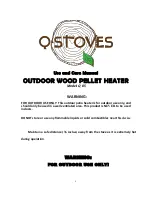
BOILER STOVE SYSTEMS –
SPECIFIC SAFETY ISSUES
• If there is a possibility that part of the heating
system may be frozen you should not light the stove
until you are confident that the system is free of ice,
has no leaks and that the water can fully circulate.
• This stove requires a dedicated non-closable air vent
of the appropriate size – see page 5.
• The system should not rely solely on gravity fed
circulation but must also incorporate a circulation
pump.
• This stove should not be connected directly to a
sealed or pressurised system without including a
safety ‘buffer’ between the systems such as a thermal
store, heat exchanger or specialist link-up component.
This will also help neutralise any pipe size difference
between the two systems which could adversely affect
performance.
•The cold feed and open vent flows must not be
fitted with any manual or automatic valve. The system
flow must not be able to be ‘closed off’ so that there
is always a clear flow route from the stove to the
system’s open vent
• In the event of a power cut or circulation pump
failure your stove will continue to produce hot
water which could be potentially dangerous. Your
system design should therefore provide for the safe
dissipation of excess hot water through a heat loss or
heat leak radiator.
• Motorised valves must revert to the open position in
the event of a power failure. This will allow heat to be
safely dissipated through the system’s natural gravity
circulation process.
• Although it is common practice for heat leak
radiators to be located in an upstairs bathroom it is
worth noting that on some boiler stove systems the
heat leak radiator can get very hot and therefore we
recommend installing a low surface temperature type
radiator and / or locating it where young children or
the infirm won’t accidentally come into contact with it
• The heat output to water from this boiler stove must
not be significantly greater than any potential usage.
The system’s heat release feature, especially if linked,
must be sufficient to prevent the system from over-
heating.
• The system design must incorporate a drain point,
preferably near the boiler stove, and be sufficient
to empty the system of any residue water during
maintenance or removal.
• All electrical connections, for example to system
valves, the circulating pump and the link-up
component must comply with current Building
Regulations. Ensure that the pipework is correctly
earthed. See page 8 and 24 for relevant regulations.
• The mains water connection to the system must
7
comply with local water authority regulations in order
to safeguard water quality and public health – see
page 8 and 24.
• The hot water cylinder thermostat should be set at
60ºC (and tested) to prevent scalding – see page 24.
HEALTH & SAFETY
During the installation of this stove and any related
building works you must comply with any current
Health & Safety at Work regulations. Always use
protective gloves and use the tool when adjusting the
air controls. When using fire cement always follow the
manufacturer’s instructions.
ASBESTOS
This stove does not contain Asbestos. However, check
that there is no possibility of disturbing any asbestos
based materials during its installation. You may
intend removing an older appliance prior to installing
your new stove, and you should be aware that the
old appliance or installation could incorporate heat
protective asbestos sheet. Use appropriate protective
equipment and seek specialist guidance at
www.hse.gov.uk/asbestos
– do not underestimate the
potential dangers of Asbestos.
FIRE CEMENT
Some types of fire cement are caustic and should
not be allowed to come into contact with the
skin. Protective gloves and glasses should be worn
when applying fire cement. In case of contact wash
immediately with plenty of water. Always read and
follow the fire cement manufacturer’s instructions.
Care should also be taken to avoid unnecessary
contact between the stove’s surfaces and the fire
cement as this could damage the paintwork. Any
excess fire cement should be quickly removed before
it hardens.
HANDLING
The Graphite Boiler stove is extremely heavy and
therefore adequate facilities must be available for its
safe loading, unloading and site handling.
METAL PARTS
When installing or servicing this stove care should be
taken to avoid the possibility of personal injury from
the stove’s metal parts.
BUILDINGS INSURANCE
It is a requirement by some building insurance
companies to inform them of the installation of a new
fixed heating appliance and a relevant certificate of
compliance produced.
Summary of Contents for GR910-B
Page 4: ...4 GENERAL DIMENSIONS ...
Page 22: ... 23 ...








































